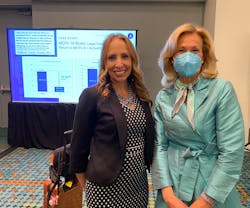What Have We Learned During the Pandemic? IAQ Matters—A Lot (BOMA 2022)
After more than two years of a global pandemic, building owners and managers are faced with a daunting challenge: improve indoor air quality (IAQ) without increasing their carbon footprint.
In their presentation on Monday at the 2022 BOMA International Conference & Expo, Dr. Deborah Birx, formerly a member of the White House Coronavirus Task Force and now chief medical and science advisor for ActivePure Technologies, and Amy Carenza, ActivePure’s chief commercial officer, shared their insights to give property professionals a path forward to operating their buildings with health and sustainability in mind.
Lessons from COVID
What we have learned over the past two and a half years of the pandemic is that the SARS-CoV-2 virus and its variants move in a very predictable pattern, according to Dr. Birx, a world-renowned medical physician and expert on HIV/AIDS and infectious diseases who also served on the White House Coronavirus Task Force from February 2020 to January 2021. Sharing data from the Centers for Disease Control (CDC), she noted that every variant arrives in the U.S. from abroad about six to eight weeks after initial detection.
“Herd immunity cannot be obtained or sustained with the current vaccines,” Birx noted, but said early data suggests they do protect against long COVID, while results are pending on whether they offer protection against inflammatory syndromes in children and adults.
While solutions for individuals remain the same (masking, vaccination, testing, social distancing), she suggested that strategies for combating the spread of infection in the workplace should include: layer protection combined with active and effective air cleaning for viral, bacterial and fungal removal in real time.
Cleaning the Air for Better IAQ
Carenza opened her portion of the joint presentation by posing a straightforward question about corporate resiliency: How important is the air that you breathe?
“When you think of your responsibilities with respect to interior air, you start to see where interior transmission is the primary factor for creating a sustainable solution” to mitigate the spread of viruses in the built environment, Carenza said. According to Carenza, the impact of indoor air has a significant impact on the planet given that buildings consume the most energy on three things:
- Space heating (25%)
- Ventilation (10%)
- Cooling (9%)
Interestingly, the White House’s COVID recommendations for building owners suggests improving ventilation in commercial buildings by increasing air changes to six per hour and upgrading filtration to MERV 13 or higher. However, as Carenza pointed out, it would take 46-69 minutes to eliminate airborne contaminants based on those air exchange recommendations—which is far too long to prevent transmission of the virus—and upgrading to more robust filtration places greater energy demands on the HVAC system that is unsustainable. “MERV filters were intended to protect equipment, not people,” she added.
The solution? Rather than simply diluting the amount of contaminants within an interior space with fresh air, which increases the amount of heating and cooling (and energy) needed, Carenza says air cleaning and disinfection technology results in superior IAQ that’s measurable and with negligible demands on energy.
“You can clean the air inside your space rather than bringing more outside air in, and you can decontaminate the air for a better result with much less use of energy,” she said.
Carenza said the science is under peer review, but initial data suggests using displacement ventilation with active air disinfection is the equivalent of 24-107 air changes per hour.
The results are significant because the office isn’t going away. It’s important for face-to-face collaboration, which comes with health risks. However, “as building owners and facility managers, you don’t need anything to go wrong; you need a positive experience where people want to come back. You need to remove the volatility of interior environments,” she said.
While facility executives can’t eliminate the human element involved in viral transmission (wearing masks, getting tested or vaccinated), they can address the contamination that those people bring into the built environment.
“When your building is safer than employees’ homes, you give them a compelling reason for them to come into the office,” she concluded.

